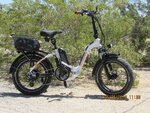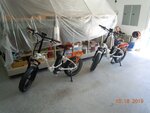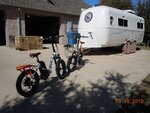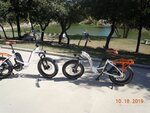Banzai
Active Member
Before plunging into the world of electric biking I used an electric scooter to shuttle about locally, strictly for the purpose of eliminating some of the need for gasoline. The scooter had a low mounted seat ensuring a good footing when necessary, and was excellent for short trips on pavement with a top speed of 18 mph. It had one limiting factor with a total range of only about 6 or 7 miles, so I kept it fully charged when not riding it. Not exactly designed for use on the sandy trails of my locale, I soon discovered that some enterprising fellow had fastened an electric motor to a fat bike and thus the RADRover became a household name, perfect for my favorite pastime of booney-hopping. But the scooter still had some benefits not usually found on bicycles, and with some insight RPB's latest addition to their lineup can well serve those looking for an electric bike that has all the conveniences of a scooter or an e-bike combined. The smaller 20" tires and low profile of the RADMini have been the perfect answer for many riders, and now RAD Power Bikes has gone one better with an even more versatile model. Scooters are typically more accommodating over bicycles in several ways, the first being to eliminate much of the physical effort to ride them. Simply hop on and go. For those who may have some injury that can make riding a bike a real impossibility, then this is when a scooter can be better utilized. Now enter the 2019 RADMini Step-Thru with top tube eliminated. With the seat lowered it replicates riding an actual scooter while only using the pedals as foot rests and powering up to 20mph with the grip throttle for a range of around 25 miles, possibly even more. A real plus in some situations. Been there, done that.
Other improvements include tires with street tread and better sealed to repel against flats. The gearing has been improved and has a nice shiny chrome sprocket cluster mounted on the rear axle and the battery has been moved from behind the seat to the front of it for easier access. The controller is now mounted on the back of the seat post instead of inside a box mounted on the bottom of the frame of the previous Mini. This version managed to somehow gain a few pounds of weight at 68 pounds, but don't we all. The front forks offer improved steering and better stability, and the bike now arrives minus a rear rack, so as received from RAD, it’s a sporty run-about, and is suitable for a wide variety of riders, young and old.
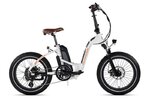
Assembly went well, with not really much to finish up after pulling it from the shipping carton. The packaging was much better for this Mini over my previous 2018 model that arrived with a front fork protruding from the box. That can't happen with the new process with the front forks anchored to a base plate, and generously padded with Styrofoam throughout with some rigid plastic sheeting fastened inside at vulnerable places for repelling impact damage during transport. Everything was zip-tied securely to restrict movement inside the box and it arrived with no holes and everything within the box was intact and in perfect condition upon arrival as delivered by FedEx.
After completing assembly I checked for loose bolts and connections, spun the wheels and checked for proper assembly and operation of the brakes and suspension. I oiled the chain and checked the tire air pressure bringing them both up to 22 pounds as recommended in the assembly video. After a full charge on the battery I installed it and went for a little test ride that went well.
The handlebar assembly is typically RAD. On this bike the handlebars sit a little too far forward for my liking forcing more weight to be placed on the grips. I prefer sitting upright so will be doing some small changes. The wires and cables are all zipped-tied neatly and don't tangle with handlebar movement. The seat post clamp has been changed and is intended to be hand tightened only. I preferred the older type better, but my Suntour post and Cloud 9 seat have not slipped down at all after several rides. The rear tail light is now wired into the brake controls and shines brightly when working the brakes. The drive train worked perfectly starting in first gear and PAS 0 and shifting thru all seven gears and back down to first without a hint of hanging up or missing any gears. Then I went thru the 5 PAS settings while in 7th gear and everything operated as normal. No wobble or squeal in the brakes at all, working perfectly while doing some hard braking tests. Operation on the sand roads wasn't disappointing either and I even checked the stability of the front wheel when doing some quick 180s in soft sand - no wash out at all. This bike is really special, and I'm really going to like riding it. It will get a rear rack and a set of fenders because I'm not likely to be running it thru any rough areas. I have other bikes for doing that.

The steering and stability when on sandy surfaces were noticeably improved during my test rides. Click on the pics to enlarge them and look carefully at the RPB ad picture of the Step-Thru and the front end shows some forward angle, made even more noticeable because the frame now sits lower than previous models. My picture shows a comparison of the front end angles on my 2018 and 2019 bikes with slightly more fork angle forward on the Step-Thru. However so slight, it does make a big difference in handling. When riding the 2018 with tire pressure above ten pounds there is a tendency to bog down when turning on soft sandy surfaces and even some front end washout when doing hard 180 turnarounds. It tends to disappear when tire pressure is dropped below 10psi. With the new Step-Thru tires at the recommended 20 pounds pressure, surprisingly they glided over sandy surfaces and the bike performed tight 180 turnarounds without a glitch.
Doing some measuring, the wheelbase on the two bikes is identical. The knobby tires show one inch more in diameter height, and the bottom of the 2018 frame sits two inches higher than the Step-Thru frame. Even though the Step-Thru appears to have a taller front end, both measure identical height to the base of the head tube. The head tube of the 2019 has one more inch in height over the 2018 to match the massive new down tube design. This also translates to two inches higher at the top of the 2018 seat tube, and with the seats of both bikes bottomed out, the 2018 RADMini seat sits three inches higher than the identical arrangement on the 2019 RADMini Step-Thru. It all adds up to more versatility and better handling, the perfect take along when vacationing.
Other improvements include tires with street tread and better sealed to repel against flats. The gearing has been improved and has a nice shiny chrome sprocket cluster mounted on the rear axle and the battery has been moved from behind the seat to the front of it for easier access. The controller is now mounted on the back of the seat post instead of inside a box mounted on the bottom of the frame of the previous Mini. This version managed to somehow gain a few pounds of weight at 68 pounds, but don't we all. The front forks offer improved steering and better stability, and the bike now arrives minus a rear rack, so as received from RAD, it’s a sporty run-about, and is suitable for a wide variety of riders, young and old.

Assembly went well, with not really much to finish up after pulling it from the shipping carton. The packaging was much better for this Mini over my previous 2018 model that arrived with a front fork protruding from the box. That can't happen with the new process with the front forks anchored to a base plate, and generously padded with Styrofoam throughout with some rigid plastic sheeting fastened inside at vulnerable places for repelling impact damage during transport. Everything was zip-tied securely to restrict movement inside the box and it arrived with no holes and everything within the box was intact and in perfect condition upon arrival as delivered by FedEx.
After completing assembly I checked for loose bolts and connections, spun the wheels and checked for proper assembly and operation of the brakes and suspension. I oiled the chain and checked the tire air pressure bringing them both up to 22 pounds as recommended in the assembly video. After a full charge on the battery I installed it and went for a little test ride that went well.
The handlebar assembly is typically RAD. On this bike the handlebars sit a little too far forward for my liking forcing more weight to be placed on the grips. I prefer sitting upright so will be doing some small changes. The wires and cables are all zipped-tied neatly and don't tangle with handlebar movement. The seat post clamp has been changed and is intended to be hand tightened only. I preferred the older type better, but my Suntour post and Cloud 9 seat have not slipped down at all after several rides. The rear tail light is now wired into the brake controls and shines brightly when working the brakes. The drive train worked perfectly starting in first gear and PAS 0 and shifting thru all seven gears and back down to first without a hint of hanging up or missing any gears. Then I went thru the 5 PAS settings while in 7th gear and everything operated as normal. No wobble or squeal in the brakes at all, working perfectly while doing some hard braking tests. Operation on the sand roads wasn't disappointing either and I even checked the stability of the front wheel when doing some quick 180s in soft sand - no wash out at all. This bike is really special, and I'm really going to like riding it. It will get a rear rack and a set of fenders because I'm not likely to be running it thru any rough areas. I have other bikes for doing that.

The steering and stability when on sandy surfaces were noticeably improved during my test rides. Click on the pics to enlarge them and look carefully at the RPB ad picture of the Step-Thru and the front end shows some forward angle, made even more noticeable because the frame now sits lower than previous models. My picture shows a comparison of the front end angles on my 2018 and 2019 bikes with slightly more fork angle forward on the Step-Thru. However so slight, it does make a big difference in handling. When riding the 2018 with tire pressure above ten pounds there is a tendency to bog down when turning on soft sandy surfaces and even some front end washout when doing hard 180 turnarounds. It tends to disappear when tire pressure is dropped below 10psi. With the new Step-Thru tires at the recommended 20 pounds pressure, surprisingly they glided over sandy surfaces and the bike performed tight 180 turnarounds without a glitch.
Doing some measuring, the wheelbase on the two bikes is identical. The knobby tires show one inch more in diameter height, and the bottom of the 2018 frame sits two inches higher than the Step-Thru frame. Even though the Step-Thru appears to have a taller front end, both measure identical height to the base of the head tube. The head tube of the 2019 has one more inch in height over the 2018 to match the massive new down tube design. This also translates to two inches higher at the top of the 2018 seat tube, and with the seats of both bikes bottomed out, the 2018 RADMini seat sits three inches higher than the identical arrangement on the 2019 RADMini Step-Thru. It all adds up to more versatility and better handling, the perfect take along when vacationing.
